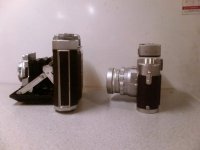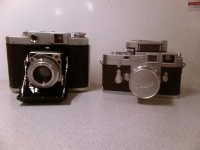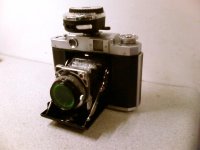chippy
foo was here
Hi,
I'd like to follow up RichC's response. My pre World War II Zeiss Super Ikonta B was one of the best cameras I ever photographed with until the cement started leaking out of the f 2.8 Tessar lens and gumming up the shutter. After two trips to the repair shop I gave up and moved on to a Rolleiflex MX and my first Leica. I hope the postwar Zeiss Super Ikonta Bs, IIIs, and IVs have a more durable cement between the elements of their Tessars! This experience leads me to think that while a three element (uncemented) lens is less well corrected than a four element one, it might be more durable over many years than a tessar type lens. The 75 mm f 4.5 Zeiss Triotar on my Rolleicord Ia was quite sharp, at least at f 8 and f 11. While the Rolleicords and f 3.5 Rolleiflexes from that era are certainly bulkier than a 120 folding camera, they provide a lot of bring home the pictures capability for their size, weight, and cost. Here's wishing you good success in your quest.
JustPlainBill
fwiw Bill, rear lens separation isnt usually a problem at all with the Tessar lenses, they are plenty durable and will outlive me and my children i am sure. even if it did separate (or other cemented lenses produced by another maker) then this is not usually the cause for gumming up the shutter, it usually just separates and you can see the crystallization. what does gum up the shutter in most cases (apart from general crud accumulating over the years and this happens with tlr or any camera) is the grease used for the front element focusing gets into the shutter. Zeiss Ikonta used front cell focusing on their folding 120 cameras (where the front cell of the lens is turned to focus) as did many other makers, this is a common problem but in most cases a good CLA will fix it. However there are a select few folding cameras such as the Welta Weltur, S/Isolette, Iskra, Bessa II, Mamiya 6 ,etc etc that that the lens is fixed (unit focusing) together and focuses as a unit (as do the TLR's).






